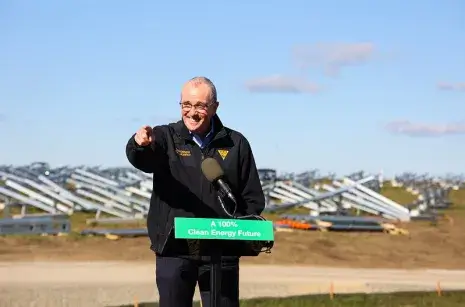Strategy 4: Deploy Strategic Mitigation
Enact Carbon Price

A carbon price increases the cost of goods to reflect the damage to health and safety of their greenhouse gas emissions. Accounting for that true cost encourages people to buy greener products. Many places already have some form of carbon pricing, but the U.S. must implement a system that covers all states. The funds raised through those higher costs should be distributed back to those in need to ensure it is not unfairly hurting low-income people.
More recommendations
Every ton of CO2 emitted into the atmosphere causes damage for which no one is currently held responsible. Because of shifting political environments, the Commission has not developed a consensus view on the right price for emissions, but offers $100 per ton of CO2 emitted as a price that may be politically feasible and send a clear signal about the need to act.[i]
The country should aspire to align the price set on carbon emissions with the full costs that carbon pollution puts on the economy and society. Those costs, known as the social cost of carbon, include the vast health care costs, estimated at $820 billion annually, from pollutants created when fossil fuels are burned.[ii] Estimates of the social cost of carbon vary widely due to different approaches to weighing current costs against future harms and benefits. However, the trend in the research is clear: estimates of the social cost of carbon are rising sharply.
Achieving a carbon price in the United States has been politically challenging, as demonstrated by the failure of the 2009 Waxman-Markey Bill to initiate a cap-and-trade system. Many of the concerns surrounding the Waxman-Markey Bill are still highly relevant to current pricing efforts, including those related to fairness, international relationships, target-setting, and revenue spending. But despite this historical context, there are several reasons to encourage continued efforts. Thirteen U.S. states have already implemented emissions trading schemes. Both taxes and trading schemes are also used internationally, especially in Europe, where an emission pricing system covers between one-third and one-half of all EU emissions.[iii]
Carbon pricing is a powerful tool to motivate decarbonization, but it will not be sufficient on its own. Particular attention is needed to address the potential disproportionate economic impact on lower-income American neighborhoods, such as through the many proposals that have focused on refunding some or all of the revenues directly to the public.[iv] This “fee and dividend” approach could be used to offset other taxes in ways that could improve the nation’s public finances and shift the taxation burden. This model has broad support, though no concrete proposal exists.[v] Through interviews, the Commission found that these ideas also commanded significant support from businesses.[vi] Such an approach would have the advantage of making the level of effort being made to cut emissions highly transparent, which could assist with the imposition of corrective tariffs on goods traded in international markets.
[i] Rebecca Hersher and Lesley Clark, “The EPA Is Updating Its Most Important Tool for Cracking Down on Carbon Emissions,” NPR, February 4, 2023, https://www.npr.org/2023/02/04/1152080009/the-epa-is-updating-its-most-important-tool-for-cracking-down-on-carbon-emission.
[ii] Donald De Alwis and Vijay S. Limaye, The Costs of Inaction: The Economic Burden of Fossil Fuels and Climate Change on Health in the United States (New York: Natural Resources Defense Council, 2021), https://www.nrdc.org/resources/costs-inaction-economic-burden-fossil-fuels-and-climate-change-health-us.
[iii] European Environment Agency, “The EU Emissions Trading System in 2021: Trends and Projections,” January 12, 2022, https://www.eea.europa.eu/publications/the-eu-emissions-trading-system-2.
[iv] Laurent Belsie, “How Regressive Is a Price on Carbon?” National Bureau of Economic Research, January 1, 2010, https://www.nber.org/digest/jan10/how-regressive-price-carbon; and James Baker III, Martin Feldstein, Ted Halstead, et al., “The Conservative Case for Carbon Dividends” (Washington, D.C.: Climate Leadership Council, 2017), 1–2, https://www.clcouncil.org/media/2017/03/The-Conservative-Case-for-Carbon-Dividends.pdf.
[v] Alec Tyson and Brian Kennedy, Two-Thirds of Americans Think Government Should Do More on Climate (Washington, D.C.: Pew Research Center, 2020), https://www.pewresearch.org/science/2020/06/23/two-thirds-of-americans-think-government-should-do-more-on-climate/.
[vi] Nick Sobczyk, “Big Businesses Say They Want a Price on Carbon,” Scientific American, April 14, 2021, https://www.scientificamerican.com/article/big-businesses-say-they-want-a-price-on-carbon/; American Academy of Arts and Sciences, Barriers to Private Sector Action (Cambridge, Mass.: American Academy of Arts and Sciences, 2022), https://www.amacad.org/publication/barriers-private-sector-action; and Anthony Leiserowitz, Edward Maibach, Seth Rosenthal, and John Kotcher, Politics and Global Warming (New Haven, Conn.: Yale Program on Climate Change Communication, 2021), https://climatecommunication.yale.edu/wp-content/uploads/2021/01/politics-global-warming-december-2020b.pdf.





